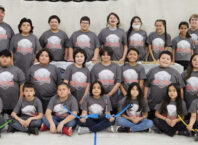By Maurita Begay
Native American communities have been one of the most affected groups throughout history when it comes to widespread pandemics. The dire circumstances of the Navajo Nation during the COVID-19 pandemic has proven that this is still true today, which is why our native communities must be informed of the importance of testing and contact tracing of confirmed and probable cases of COVID-19 infection.
Each state and local program is handling their testing and contact tracing according to their own jurisdiction-specific protocols. Here are the basics of Minnesota coronavirus testing and contact tracing procedures.
If an individual is experiencing symptoms and believes that they have been exposed to COVID-19, they should contact a healthcare provider where they will determine if testing is needed. The types of COVID-19 tests available are the nasal swab, or saliva swab test, and the antibody test.
The nasal swab test requires that a healthcare provider inserts a long stick, with a soft brush at the tip, into an individual’s nose. The stick must reach into the entire nasal passageway to collect secretions from the base of the nose to the back of the throat. A similar procedure is performed to take a saliva swab test through the mouth to the back of the throat, but a nasal swab test is preferred to confirm current infection in a patient.
The antibody test, also known as a serology test, requires that a health provider draws blood from an individual. This test can confirm if the patient was ever exposed to the virus. It indirectly detects the presence of antibodies in the bloodstream, showing that the patient has had an immune response to a strain of the coronavirus at some point in time.
Antibodies are blood proteins that combine with foreign substances to counteract antigens in the human body, and often take from one to three weeks from the time of infection to form. If an individual is tested too early for antibodies, the results may be inaccurate.
In some areas, the antibody test is preferred, but its effectiveness is uncertain because it has not been thoroughly studied and has only received temporary approval from the Federal Health Administration (FDA). A nasal swab test, however, must be done to diagnose a patient who is currently infected with the virus.
For now, these are the only types of tests approved by the FDA. And, because of supply shortage, testing may be prioritized to higher-risk populations, such as industry and People of Color and Indigenous (POCI) workers.
Results for a COVID-19 test can take several days, and the healthcare facility where you got tested will get the results to you.
While waiting to be tested or waiting for the results, an individual is advised to self-isolate by staying in a designated area away from uninfected individuals, and to practice sanitary protective measures. If a test is confirmed positive, the results are shared with the patient; local, tribal, and state level public health officials; and, Federally Qualified Health Centers (FQHCs), like the Centers for Disease Control and Prevention (CDC).
An individual with a confirmed positive COVID-19 test then becomes a Person Under Investigation (PUI), also referred to as the “index case,” in the contact tracing process.
Contact tracing is a public health investigation aimed to identify, assess, and manage “contacts” of the PUI who were exposed to COVID-19. It is important to understand that being under investigation for COVID-19 exposure does not mean that an individual has done anything wrong. This is a free, confidential, culture-sensitive public health measure to prevent additional transmission of the disease.
The first step to contact tracing is to notify the PUI of their status in a language they understand and connect them with the care and resources they need. Elizabeth Ruebush, Association of State and Territorial Health Officials (ASTHO) Director of STD, HIV, and Viral Hepatitis, says, “If your public health department is reaching out to you as part of a COVID-19 case investigation or contact tracing effort, it’s really helpful to engage in that conversation openly and honestly. Doing so can help keep your community safe and also link you to appropriate medical care or social supports to help you out during isolation or quarantine.”
Next, the PUI is interviewed to verify their demographics and analyze their entire infectious period hour-by-hour, starting from 48 hours before showing symptoms to the point when it is safe for the PUI to stop isolating.
Then, individuals who are identified as close contacts of the PUI are located and notified of their contact status, and are advised to self-quarantine and to practice sanitary protective measures. A close contact is specified as someone who was within six feet of the PUI for at least 15 minutes during the PUI’s infectious period. Locating and notifying close contacts may be prioritized based on the extent of exposure.
Lastly, the contacts are assessed and monitored for infection. If any contact tests positive for COVID-19, they become a PUI in another investigation.
The Minnesota Department of Health continues to conduct research for adapting contact tracing to their patients’ cultural and language needs. The ultimate goal is to subdue misunderstanding and mistrust of the contact tracing process.
Ruebush reaffirms that, “The best contact tracing programs are for the community and by the community – it’s important to hire contact tracers who are part of the community they’re serving. Contact tracers who are Native American will be best positioned to serve native communities, as they’ll have a strong understanding of the local languages spoken, community resources available, and the cultural dynamics that influence how people describe and communicate their symptoms and interact with people in ‘helper’ or authority roles.”
Each individual is entitled to being well-informed of the transmission and intervention of the novel coronavirus. The testing and contact tracing processes are inherently designed to protect our communities and treat Persons Under Investigation and their close contacts as people, first and foremost.
“The ASTHO/NCSD [National Coalition of STD Directors] course provides a foundational training in contact tracing that we hope state, local, and tribal health authorities can build off of, and augment with additional training that is specific to their community needs and local protocols,” Ruebush advises.
For information about the free online ASTHO/NCSD Contact Tracing course, visit: https://www.astho.org/COVID-19/Making-Contact-Tracer-Training/
A guide for assessing symptoms and understanding testing procedures, titled “Symptoms and Testing: COVID-19,” is also available on the Minnesota Health Department’s website at: https://www.health.state.mn.us/diseases/coronavirus/symptoms.html







